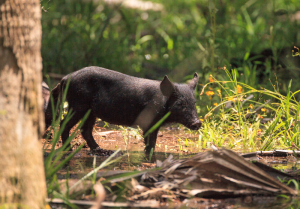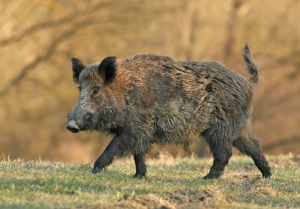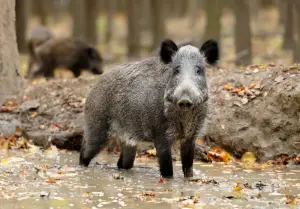Eating Feral Hogs And Wild Boar
Most of us have eaten domestic pig, with pig meat being one of the most widely consumed meats in the world. But have you ever considered eating feral or wild hogs? Is it even safe to eat these cousins (or descendants) of our domesticated friends?
Can you eat feral hogs and wild boar? Yes, you can eat feral hogs and wild boars. The taste is unlike the taste of domestic swine due to the differences in diet and activity level. As with all meat, both wild and domesticated, you will need to follow specific safety measures when handling and cooking to ensure the meat is safe for consumption.
Read on to learn more about these animals and how to safely prepare and consume them.
Are Feral & Wild Hogs Safe To Eat?
You can eat feral and wild hogs safely using the same precautions you would use with any other game.
There are a total of 24 diseases that you can contract from a wild or feral hog. The most common disease contracted from these hogs is a bacterial infection called brucellosis. Brucellosis can cause severe illness, and symptoms are not noticeable until weeks after the initial infection.
Symptoms include fever, chills, and fatigue, but fortunately, this illness can usually be treated with antibiotics. Brucellosis can infect a person if the blood of the infected animal comes into contact with someone’s mouth, eyes, nose, or through any cut in the skin. For this reason, it is essential that proper handling techniques are used.
Other common bacterial infections that a wild hog can give you include e. Coli, and salmonella. Trichinellosis is another common disease that can be passed from hogs to humans, and this is a parasitic infection.
Reading the words “24 diseases” might make you think twice about consuming wild and feral hogs, but it shouldn’t. There are a host of diseases that you can get from eating any animal – from wild game, like deer, to domesticated farm animals like chicken. Proper handling and cooking techniques will help you to stay safe.
Safely Handling Feral / Wild Hogs
You will need to properly handle the animal as you process and butcher the carcass. To protect against bloodborne pathogens (like the previously mentioned brucellosis), you will want to take precautions.
Wear gloves on your hands and safety glasses over your eyes. If you can, wear a mask as well. Make sure that any open cuts on your skin are covered securely. This will help prevent the animal’s (possibly infected) blood from coming into contact with your body.
There are some warning signs to watch out for when you open up a carcass. Signs that you are processing an unhealthy animal:
- A bluish, greenish, or yellowish tint to the meat
- Abnormally slimy or dry flesh
- Meat that is emitting a foul odor
- Any other obvious signs of illness
If you encounter any of these signs during processing, you will want to stop and contact a game warden so that they can ensure the local population is healthy.
Safely Preparing Feral / Wild Hog Meat 
As you are butchering the carcass, you should cool the meat as quickly as possible to avoid bacteria growth. If you are on a hunting trip, know that you can safely keep a carcass on ice for a maximum of 7 days, so long as you refresh the ice each day. Once butchered, you can keep the raw meat in the refrigerator for 1-2 days or wrapped in the freezer for up to 6 months. You can keep your cooked pork in the refrigerator for 3-4 days.
While you can use most of the organs of any animal, you will want to avoid the intestines. Intestines are full of harmful bacteria, and when handling the carcass, you should take extra care to avoid puncturing any holes in the intestines. Handle the organs gently to keep the intestines intact, and discard them properly.
When you cook your wild or feral hog, you will want to make sure to cook it to a minimum of 160 degrees Fahrenheit. This is the same across the board when it comes to swine – feral, wild, or domesticated. Cooking to 160 degrees will ensure that any harmful bacteria or parasites have been sufficiently killed, rendering the meat safe for consumption.
The Taste Of Feral & Wild Hog Meat
You now know that you can safely eat wild and feral hog meat. But would you want to? What does it taste like?
Feral and wild hogs will have a “gamier” taste, and if you have ever eaten venison or other game, you know what this means. They will have an earthier, even nuttier taste to them. Whether this is a better or worse taste than the domesticated hog is really a matter of personal opinion.
Like all game, the older animals will tend to be tougher than the younger animals. For this reason, aim to hunt a medium-sized hog, between 50 and 125 pounds. A hog this size will be more tender than an older, larger hog.
It is said that feral and wild hog meat taste similar, though they do not taste anything like their domesticated relatives. This is likely due to the differences in both diet and activity level.
Dietary Differences
A domesticated hog will eat a diet high in grain – this is necessary to get the hogs to a commercial weight as quickly and efficiently as possible. However, hogs are actually omnivores, eating both plants and meat. Both feral and wild hogs will have a diet high in plant matter, and this will cause the meat to naturally taste different than the meat of a commercially-raised hog.
Differences In Activity Level
Feral and wild hogs are also much more active than domesticated hogs. Domesticated hogs have it made – they are fed on a regular basis, never having to worry about where their next meal is coming from. A feral or wild hog, on the other hand, will spend the vast majority of its day searching for food to eat. This means that feral and wild hogs are much more active than domesticated hogs – causing them to be much leaner and more muscular. You probably won’t get a lot of good, fatty bacon off of a feral or wild hog.
Eating Feral Hogs & Wild Boars: Terminology 
It’s important to sort out some of the terminology used to describe these animals. Are hogs the same as boars? Does “feral” mean the same thing as “wild”? The short answer to both of these questions is “no” – read on to learn more about these terms.
Hogs vs. Boars
There is a lot of confusion around terms used to describe swine, and that is probably because there are so many of them that are commonly used. Are they hogs or pigs? Are they the same as a boar?
Hogs are members of the swine family and are typically used to describe large swine (specifically, a hog should be over 120 pounds). Hogs can be used to describe both male and female hogs. Hogs can be domesticated, feral, or wild.
Boar are male pigs that have not been castrated. An uncastrated domestic male hog is called a boar, and a wild male hog is also called a boar. Females are called sows – whether domesticated or wild. “Wild boar” is often the term used to describe wild pigs or wild hogs.
Feral vs. Wild
Many people use the terms “feral” and “wild” interchangeably, but they are not the same at all. The key difference is where the animal’s ancestors are from.
“Feral” refers to an animal that was previously domesticated (or whose ancestors were domesticated), that is now living in the wild and has lost many of its domestic qualities. Most of us are familiar with feral cats – feral cats are simply domesticated cats that have been raised in the wild.
They are fearful of humans and are not tame. But they are of a domesticated variety of animal. The same can be said for feral horses. The so-called “wild” Mustangs are not wild at all but rather are feral because they all came from domesticated horses.
“Wild” is just that – they are wild and untamed. Truly wild animals are free of breeding influence by humans and have never been domesticated. Therefore they will maintain their wild tendencies in their natural habitats.
When we talk about “wild hogs”, we usually are referring to feral hogs. True wild hogs are native to parts of Europe, Asia, and Northern Africa. Feral hogs, on the other hand, can thrive almost anywhere and can be found on almost every continent. Feral hogs are less cooperative with one another, having lost some of the “herd mentality” that is so valuable to wild hogs. Wild hogs live in groups called “sounders”, where the boars protect the herd, and the sows work together to raise the young.
Eating Feral & Wild Hogs
Eating feral and wild hogs is not only safe but can be a treat, depending on your taste preferences. Just make sure that you follow proper handling and cooking techniques, as you would when preparing any meat!

